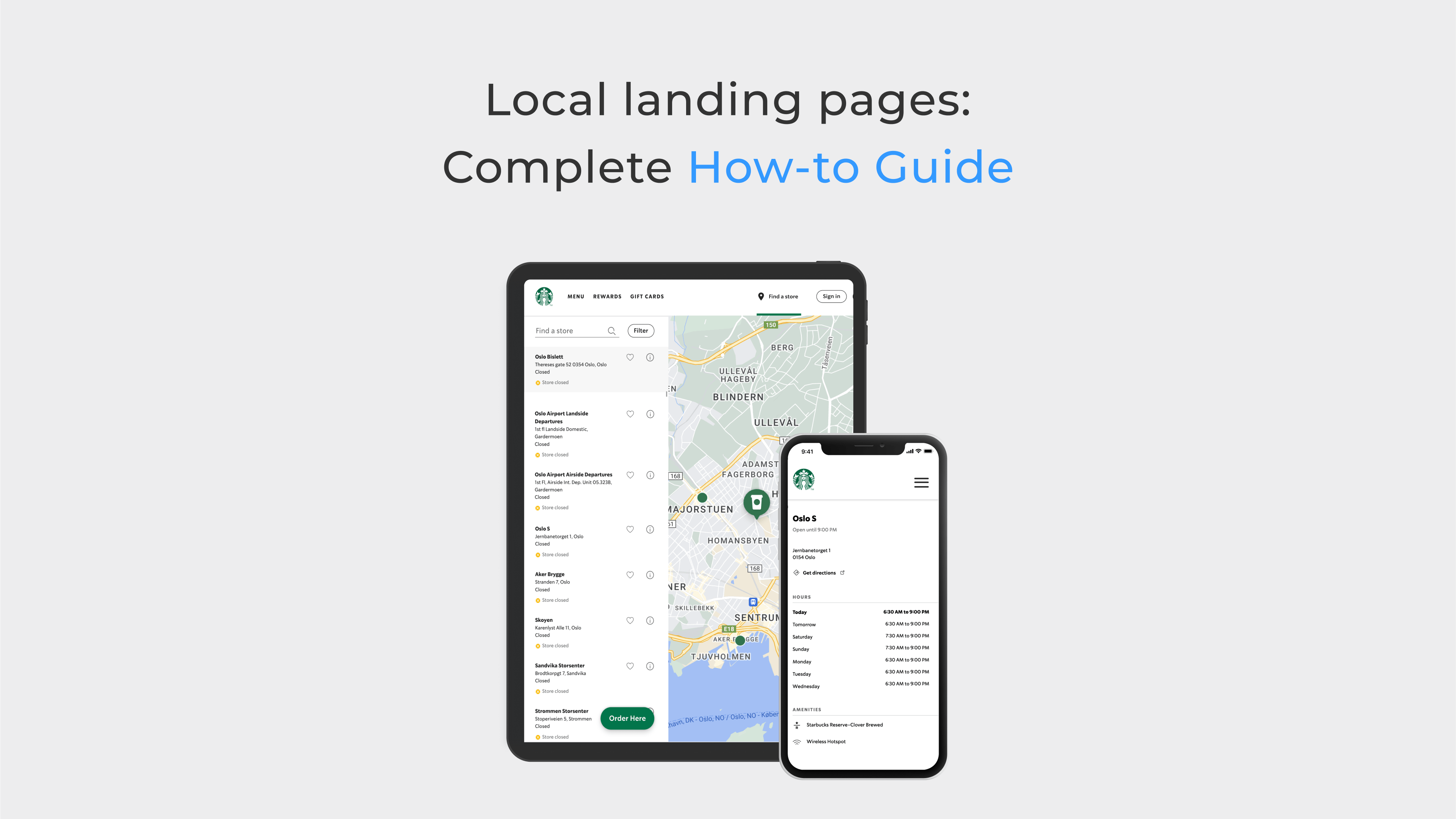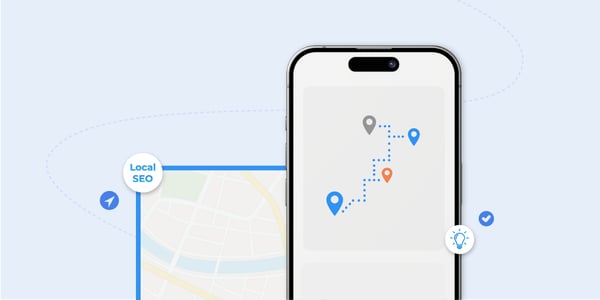Any business can benefit greatly from a successful local SEO strategy, but when it comes to multi-location businesses, the game changes completely. And that's where local landing pages come into play.
In this article, we'll define what local landing pages are, explain why they're important, and how you can create one. We’ll also show an example of a well-optimized local landing page and explain why it would work.

What Exactly Are Local Landing Pages?
Local landing pages are web pages that are tailored to a specific geographic location or service area.
The ultimate goal of developing a local landing page is to rank higher on local search results while effectively showcasing your products or services to the local customer.
They provide information about a business's products or services that are specific to a particular location or region, and they may include details like the business's address, hours of operation, or local contact information.
Why Are Local Landing Pages Important?
Local landing pages have a great potential to help websites rank on the first page of search results for local keywords, even in a competitive SEO market. This is because search engines like Google want to show users results that are the most relevant and personalised to them, and local landing pages are a sound way to meet this need.
Getting a first-page ranking is never easy, especially if you're in a crowded niche, but local landing pages can be a huge win, if you create pages that speak to your local audience rather than the global audience.
How Are Local Landing Pages Different from Regular Landing Pages?
The answer is fairly simple: Regular landing pages are more generalised, while local landing pages are focused on a particular geographic area.
For instance, you could create a regular landing page that highlights the benefits of your service and encourages visitors to sign up for a free trial. This page would be aimed at a broad audience of potential customers.
However, if you also have offices in multiple cities, it is best to create a few local landing pages that provide more information about your service as well as specific location details. These local pages would be aimed specifically at people in that city who might want to pay you a visit in person.
How to Create a High-Ranking Local Landing Page in 6 Steps
1. Research your market and competition
To create a winning local landing page, you need to know your market and competition. Use tools like Google Analytics and Google Search Console to analyze the local search engine results pages (SERPs) and identify the top-ranking pages.
This data will give you insights into the local keywords that perform well, the content that resonates with the target audience, and the technical SEO elements that contribute to a high ranking. Use this information to see what content they provide, which local keywords they target, and how your landing page differs from theirs.
2. Define your goals and audience
Before you create a local landing page, you need to know what you want to achieve and who your target audience is. Use data from Google Analytics or customer surveys to determine the demographic and psychographic characteristics of your ideal customer.
Make sure you have data-driven answers to two key questions:
1. Where do you want your visitors to come from?
2. Where are most of your local visitors coming from right now?
Once you have a clear idea of both, delve deeper into the desired actions you want visitors to take, and how you can appeal to them on a personal level.
*Tip: Customer reviews are the bread and butter of your local SEO strategy, and they help potential customers trust and choose your business so include a bunch of them.
3. Choose the best location and keywords
For multi-location brands, choosing the right location for your landing page is essential. You need to pick the locations that have the most search volume and the highest potential for conversion. You can use tools like Google Keyword Planner, Semrush, or Ahrefs to identify the most popular search terms and locations for your industry.
When choosing keywords, it's important to strike a balance between specificity and relevance to the target audience's search intent. For example, if you're creating a local landing page for a restaurant in a popular tourist area you might want to focus on keywords that highlight the restaurant's location or its proximity to a popular attraction.
*Tip: Prioritise the transactional keywords over informational ones. Instead of keywords like "coffee beans" or "coffee brewing methods," try "best coffee in Oslo," "coffee near me in Oslo," or "local coffee shop in Oslo."
4. Design and structure your landing page
When creating your local landing page, use a clean and professional design that is consistent with your brand's look and feel. This means incorporating your brand's color scheme, typography, and other design elements into a visually appealing and cohesive page. A consistent design can help build trust with potential customers and reinforce your brand's identity.
When organising the content on your landing page, keep in mind that visitors should be able to quickly and easily find the information they're looking for. Use a logical and easy-to-read layout that makes it clear what your business offers and how it can benefit potential customers.
Also, Clear calls to action (CTAs) should be prominently displayed on the page, encouraging visitors to take the desired action. This includes strategically placing CTAs on the page and using language that communicates the benefit of taking the desired action.
*Tip: Including local keywords in the URL of your local landing page can help to reinforce its local focus.
5. Optimize for Local SEO
Optimizing your local landing page for SEO is critical for attracting organic traffic. Here are the key things to consider:
Local Keywords
Use local keywords in the metadata (title tag, description, meta keywords) as well as the page title, headings, and content. This helps search engines understand the context of your landing page and its relevance to local search queries.
Also, don’t be afraid to pick low search volume or even 0 search volume keywords. While it might seem counterintuitive to target keywords that no one is searching for, the truth is that low-volume keywords can actually be highly targeted and offer less competition. By targeting these types of local keywords, you can potentially rank higher in search results and attract highly qualified traffic to your local landing page.
*Tip: Including local keywords in your local landing page's URL can further reinforce its local focus.
Consistent NAP
Ensure your NAP (name, address, phone number) is consistent and accurate across the entire website i.e. use the same NAP information on your local landing page, your website's footer, and any other directories where your business is mentioned. This consistency helps search engines understand that your business is a legitimate and trustworthy local entity.
Alt Text
Include relevant and location-specific keywords in the Alt text of your website's images so that the search engines can better understand the context of your content which will improve your chances of ranking higher in local search results. For example, if you’re a coffee shop in Oslo, including keywords like "Oslo coffee shop," "locally roasted coffee in Oslo," or "coffee near me Oslo" in your images’ Alt Text will boost your local SEO.
Schema Markup
Use schema markup on your local landing page to communicate the key details about your business like your NAP, hours of operation, reviews, etc. in a structured and standardized way that search engines can easily understand. This will also help your business appear in snippets - highly visible and eye-catching results that appear at the top of search results, showing your reviews, ratings, pricing, and other essential information.
*Tip: Embed a Google Map on your local landing page to help customers find your business easily. This will also signal search engines that your business is located in a specific area.
6. Test and refine your local landing page
Use A/B testing to compare different variations of the local landing page and see which performs best. Test elements such as the headline, call-to-action, form placement, and overall design to see what resonates most with your local target audience.
Use tools like Google Analytics to track the page's performance and gain insights into how visitors interact with it. Keep an eye on metrics like bounce rate, time on page, and conversion rate to identify areas that need improvement.
Too twisted? Here’s an example
We've created a bakery chain called "Sweet Delights" with multiple locations throughout London. To demonstrate the key components of a strong local landing page, here is a mockup of a local landing page for their Westminster branch:
- Page Title: Freshly Baked Treats | Sweet Delights Bakery Westminster
- Meta Description: Looking for a delicious bakery in Westminster? Sweet Delights serves up freshly baked treats made with high-quality ingredients. Visit us today and indulge in a little sweetness!
- Headings: "Our Baked Goods," "Why Choose Sweet Delights," "Find Us," "Order Online"
- Content: The content on the page includes a description of the bakery's history, the list of their locations, information about the ingredients used in their baked goods, and the popular menu items such as cakes, pastries, and bread. The page also includes customer reviews, which provide social proof and help build trust with potential customers.
- Calls to Action (CTAs): The page suggests several CTAs like "Order Online," "Find Us," and "See Our Menu’’ encouraging the visitors to take action and engage with the business.
- Design & Structure: The page has a clean and professional design that is consistent with the brand's look and feel. The content is organised in a logical and easy-to-read manner, with headings and subheadings that make it easy to scan. The page also includes high-quality images of the bakery and its baked goods, which help make the page more engaging.
- Local SEO: The page includes local keywords in the page title, meta description, and content, such as "bakery in Westminster" and "freshly baked treats." The business's NAP (name, address, phone number) is also consistent and accurate across the entire website, which helps improve local search rankings.
To Sum Up
Local landing pages are essential for any business that wants to succeed in local SEO. They help you reach and connect with local audiences, increase your online visibility, and drive traffic and sales to your business. By following the steps outlined in this article, you can create a high-ranking local landing page that will set you apart from the competition and help you achieve your KPIs. So, go ahead and give it a try!
Find more helpful Local SEO tips and much more in our blog.
Lily Adamyan, February 24


